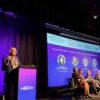With the lifting of lockdowns and restrictions there is some sense of euphoria emerging, though many in our universities will be reaching year’s end with, in many cases, relief and exhaustion. There is a great opportunity for leaders to start thinking in new ways about how they can set their institutions and staff up for 2022 and beyond. What does next year, the next 3-6 years, and the next decade from now look like?
One thing that is crucial in all of these timeframes is the ability and willingness to listen, closely and sincerely. Now is the time to listen to demonstrate that we have heard the key messages from the policy-makers, the staff we lead, the partners that can help us, and from our students.
In the shortest time frame of 2022, there is a bit more bounce on campus with increasing vaccination rates and announcements of open borders. At the moment, there is still quite a bit of unknown detail, but the sense is that many current students will be able to return in the first half of the year and we will begin to see the trickle of new international students from mid-year. That is probably half a year earlier than the consensus view a month ago.
There is a sense we’ve been tested by the shock of borders closed by the pandemic and the longer brewing domestic funding cap, but some greater certainty is on the horizon.
The medium term will be interesting. Will the Job Ready Graduates reform be bedded down and able to deal with the increased demand from the Costello baby boom peaking in 2023 and 2024? Definitely the rhetoric coming out of universities about their pivot towards work integrated learning for all suggests some elements have been taken up.
Will the closed borders of 2020-2021 result in a permanent loss of market share to competitor countries for international students, or will pent up demand cause a 1920s style bubble? With a federal election in 2022, the answer to these questions will hinge in part upon that outcome.
Moving from the medium to the longer term, the question is can the sector ‘build back better’, using the phrase coined after the Boxing Day Tsunami? Both Job Ready Graduate reforms and the pandemic shock are opportunities to reconstitute how universities look internally and externally.
Job Ready Graduates nudged for a distribution of students more closely aligned with Australian skill needs (more health, education and STEM) and broader regional distribution (more regional and outer suburbs). The funding of the disciplines was the red herring that caught the media and casual observer’s attention, but the much more interesting and important shift was the move away from a fixed number of ‘places’ in certain disciplines and study levels to a flexible envelope model.
This envelope model puts much more agency and power in the hands of individual students and institutions. Like the demand driven system, students are free to choose where their interests lie, not where some government agency has allocated a ‘place’.
Universities have agency too and are free to move their funding to align with their specific mission. Thus, Swinburne University can make a commitment to its roots with a technology and industry focus. A university with a postgraduate coursework focus, or one with an enabling student focus, can shift funding up or down the AQF levels. And, the University of Newcastle, with a statutorily defined catchment the size of Belgium, can choose a community-focused approach that covers the breadth of their particular local student and industry needs and desires.
In the ten-year timeframe, the new ‘bit education’ models, private providers and EdTech will be tested. Some will pass, but like Netscape some models will be forgotten. The successful operators will be the ones who listened. Policymakers of all stripes are talking about more dynamic education with micro-credentials and industry skills alignment. Students are talking about the frustration of being a number within a massified system and loss of student experience. Staff are talking about work flexibility and hefty workloads.
As listeners, the sector appears to be in three groups. Firstly, those that have listened to the wave of policy change being made, and heard early enough to change and respond. Secondly, those that have heard but are watching and waiting. And finally, those that may not be fully aware of how the underpinning business models need to change. As the old quote goes, if you don’t know which group you are in, you are in trouble.
The skills to listen to the sector’s policy masters might be similar to those related to listening to what students, staff and partners are telling us about their experiences right now. As student evaluations are completed, and as staff engagement surveys are undertaken by some, there is much to listen to.
We might need some more specific and particular means of giving voice to external partners, employers and providers if we are to fully align our future directions with their needs. Everyone’s needs and expectations appear to have changed significantly.
The most important way forward will be for leaders to revisit strategies in the light of everything that is now emerging. This will not be well served by conventional approaches to strategy setting that comes with five-year plans, and annual reporting of fixed KPIs. It is suited to more radical, turnaround processes of three horizon strategy planning. This would be well-informed by facilitated processes that draw in the stakeholders that have things to say, that we all need to now hear. This was a key theme coming out of our conversation on the HEDx podcast last week, and the commentary on it, which you can listen to here.
By Martin Betts & Kent Anderson
First published in Campus Review on 2nd November 2021








